Valparaiso: Head in the clouds and feet on the ground
28 January, 2008, 11:26 am in "Chile"
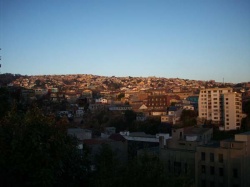 We have our techniques for arriving in a city and getting settled without reservations: Usually we go towards an area with a few hotels listed in LP, or head to the center of town. We find a cafe (have breakfast if arriving early from a night bus) and Rowshan guards the bags while I scout for hotels. This generally works, however, Valparaiso is not set up like the "usual" town. First of all, there isn't really a definite center. Second, most of the budget lodgings are in family run b&b's and no one is up until about 9. Third, the lodging is in residential areas so nothing is open until 9. This is great for people who like to sleep in but bad when you arrive at 6 AM, dazed and bleary from an overnight bus.
We have our techniques for arriving in a city and getting settled without reservations: Usually we go towards an area with a few hotels listed in LP, or head to the center of town. We find a cafe (have breakfast if arriving early from a night bus) and Rowshan guards the bags while I scout for hotels. This generally works, however, Valparaiso is not set up like the "usual" town. First of all, there isn't really a definite center. Second, most of the budget lodgings are in family run b&b's and no one is up until about 9. Third, the lodging is in residential areas so nothing is open until 9. This is great for people who like to sleep in but bad when you arrive at 6 AM, dazed and bleary from an overnight bus.We headed to the hills Concepcion and Alegre, where there seemed to be a concentration of lodging, and found padlocked gates. When a tired voice did answer my phone call, we were told to call back after 9. These are the most difficult times while traveling: you want just 3 things: to eat breakfast, use a toilet, and take a nap. Instead you are forced to find a park bench and wait in the semi-darkness. We found a plaza with benches, one containing a sleeping occupant. The plaza happened to perched on an overlook. We looked over the city at the harbor, listening to the seagulls' morning cries. The seagulls and the view reminded us a bit of Istanbul.
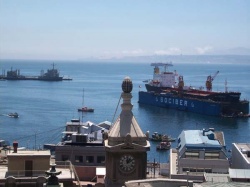
Then the sun slowly began to rise. The scene became gently washed with colors and it was impossible not to be struck by what a beautiful place we were at, high on a hill above the city, with the palace of Belles Artes behind us.
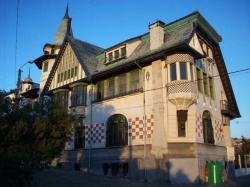
Around 7:30 I decided to do another round of the neighborhood looking for signs of life. Eventually I found a b&b owner who was up and about. By 8:30 I had even found an open cafe. Life is good.
Rowshan and I had breakfast, checked into the B&B and another tough arrival was vanquished. Later, we descended into the lower part of town. This is the other confusing thing about Valparaiso. The town has two parts: the lower part alongside the water and the residential part in the hills above. The hills where we are staying are UNESCO historical sites so I imagine they might be more beautiful than the others which I haven't seen yet. The hill we are on is ethereal--perched above the city; there are cafes, galleries; historic houses with high ceilings, and the smell of fresh baked bread drifting from bakeries.
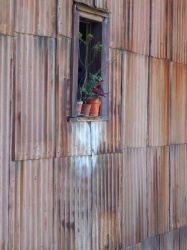
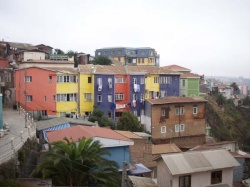
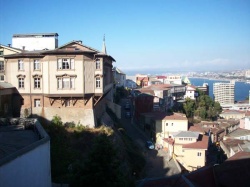
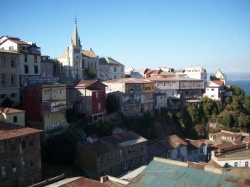
It is a place for enjoying life but in a refined way. Descending to the lower part of the city is a little like leaving the clouds and landing in the dirt. It is a place grayed by car exhaust where even the historic buildings, painted in pastel colors have been dulled. In many places at street level the neo-classical columns and pastel paint have been replaced by large modern glass panes and metal as well as big plastic signs whose bright colors have been shaded by exhaust. The quiet simplicity and the silence of the hills, broken only by seagulls cries is torn asunder by the roars of buses and taxis, the blare of shelves of TVs, rows and rows of cheaply made products, posters screaming out deals and the cacophony of the modern world.
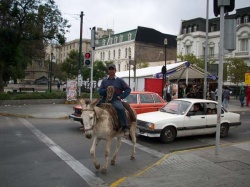
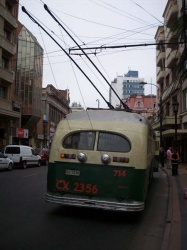
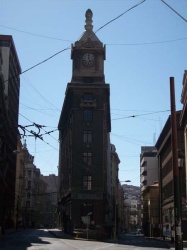
The lower part of town is where the mundane takes over: markets, fast food; stores... In front of the buildings is the port where there is once again a flash of color as the buildings give way to shipping containers, toy cars in a park, and restored buildings on the waterfront.
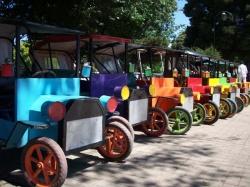
These two worlds are connected in many places by historic "elevators", small funiculars capable of holding about 7 people in each car.
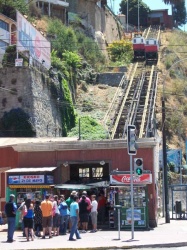
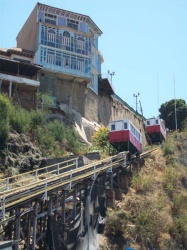
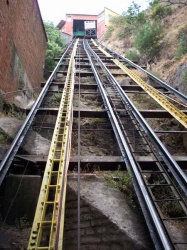
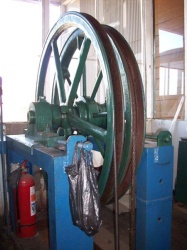
After a lunch of pizza, chicken, french fries, and ice cream, as well as a trip to the station to buy bus tickets, I was already missing the serene elegance of the hills.
Comments
- Comments
Powered by My Blog 1.69. Copyright 2003-2006 FuzzyMonkey.net.
Created by the scripting wizards at FuzzyMonkey.net..
(Code modified by Rowshan Dowlatabadi)
Created by the scripting wizards at FuzzyMonkey.net..
(Code modified by Rowshan Dowlatabadi)

